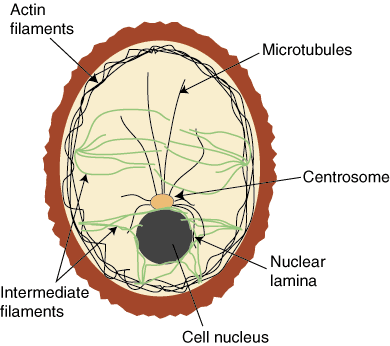In this section we will discuss the intracellular components that are not organelles. The cytoskeleton and cytosol are structural elements that help provide the cell with its structure. The cytoskeleton is composed of protein filaments and is found throughout the inside of a eukaryotic cell. The cytosol is the main component of the cytoplasm, the fluid that fills the inside of the cell. The cytoplasm is everything in the cell except for the cytoskeleton and membrane-bound organelles. Both structures, the cytoskeleton and cytosol, are "filler" structures that do not contain essential biological molecules but perform structural functions within a cell.
The Cytosol
The interior of a cell is composed of organelles, the cytoskeleton, and the cytosol. The cytosol often comprises more than 50% of a cell's volume. Beyond providing structural support, the cytosol is the site wherein protein synthesis takes place.

Figure 2.01: Location of the cytosol within a cell.
The Cytoskeleton
The cytoskeleton is similar to the lipid bilayer in that it helps provide the interior structure of the cell the way the lipid bilayer provides the structure of the cell membrane. The cytoskeleton also allows the cell to adapt. Often, a cell will reorganize its intracellular components, leading to a change in its shape. The cytoskeleton is responsible for mediating these changes. By providing "tracks" with its protein filaments, the cytoskeleton allows organelles to move around within the cell. In addition to facilitating intracellular organelle movement, by moving itself the cytoskeleton can move the entire cells in multi-cellular organisms. In this way, the cytoskeleton is involved in intercellular communication.
The cytoskeleton is composed of three different types of protein filaments: microfilaments, microtubules, and intermediate filaments. Actin is a protein that is the main component of microfilaments, which are double-stranded, thin, and flexible structures. Most actin molecules work together to give support and structure to the plasma membrane and are therefore found near the cell membrane. Microtubules are long, cylindrical structures composed of the protein tubulin and organized around a centrosome, an organelle usually found in the center of the cell near the cell nucleus. Unlike actin molecules, microtubules work separately to provide tracks on which organelles can travel from the center of the cell outward. Intermediate filaments are the final class of proteins that compose the cytoskeleton. These structures are rope-like and fibrous. The filaments help to resist stress and increase cellular stability. These three types of protein are distinct in their structure and specific function, but all work together to help provide intra-cellular structure. Because they are so diverse, it is very difficult to study the specific functions of the cytoskeletal components.

Figure 2.02: Organization of actin, microtubules, and intermediate filaments within a cell.













